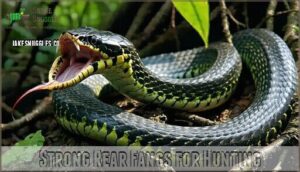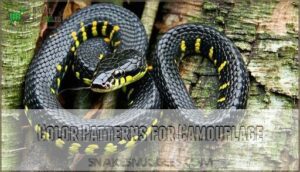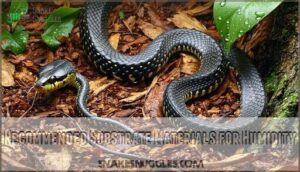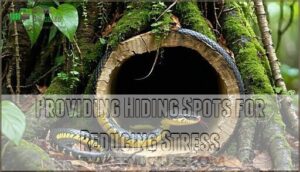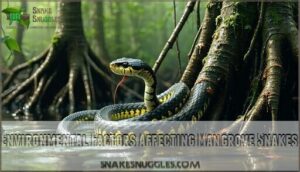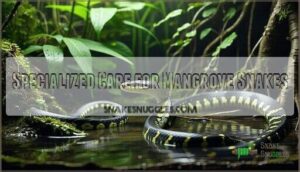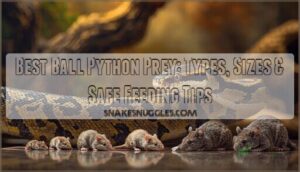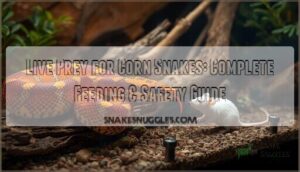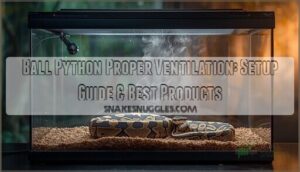This site is supported by our readers. We may earn a commission, at no cost to you, if you purchase through links.
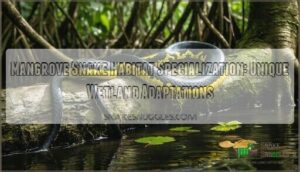
They’re built like nature’s perfect tree climbers, with triangular bodies that grip branches effortlessly while they bask 100 feet up during the day.
At night, they descend to hunt, using their rear fangs and specialized venom to immobilize prey.
Their striking yellow-and-black banded patterns aren’t just for show—they provide excellent camouflage among dappled forest light.
What’s remarkable is how every aspect of their physiology reflects this unique niche, from their climbing abilities to their hunting strategies, showcasing a perfect adaptation to their environment.
Table Of Contents
- Key Takeaways
- Mangrove Snake Habitat Types
- Adaptations for Mangrove Environments
- Habitat Requirements for Captivity
- Environmental Factors Affecting Mangrove Snakes
- Specialized Care for Mangrove Snakes
- Frequently Asked Questions (FAQs)
- Are mangrove snakes arboreal?
- What temperature do mangrove snakes like?
- What is the habitat of a snake?
- Can mangrove snakes be housed together?
- How to care for a mangrove snake?
- Are mangrove snakes carnivores?
- What is the lifespan of a mangrove snake?
- What colors are mangrove snake markings?
- How does mangrove snake reproduce?
- What do mangrove snakes eat in the wild?
- Conclusion
Key Takeaways
- You’ll need a specialized arboreal habitat setup – These triangular-bodied snakes require tall enclosures with climbing structures, not traditional ground-focused setups, since they spend most of their time 100 feet up in mangrove canopies.
- Temperature and humidity control is critical – You must maintain temperatures of 78-85°F with 70-80% humidity, using moisture-retaining substrates like cypress mulch to replicate their Southeast Asian wetland environment.
- Their rear fangs and specialized venom make handling dangerous – You’ll need 18-24 inch tongs for safe interactions, since their neurotoxin-packed venom (like denmotoxin) is specifically designed to immobilize birds and small mammals.
- Stress reduction through proper acclimation prevents feeding issues – You’ll face anorexia problems if you don’t provide adequate hiding spots, minimize disturbances during quarantine periods, and gradually introduce environmental enrichment over 4-6 weeks.
Mangrove Snake Habitat Types
You’ll find mangrove snakes thriving in specialized wetland habitats across Southeast Asia, where they’ve adapted to both coastal mangrove forests and humid lowland rainforests.
Southeast Asia’s wetland masters thrive where tropical waters meet ancient forests, perfectly adapted to their aquatic arboreal world.
These remarkable serpents navigate between terrestrial ground hunting and arboreal canopy living, making them perfectly suited for the complex, water-influenced ecosystems they call home.
Mangrove Forests
When you explore mangrove forests, you’ll discover the perfect hunting grounds for these specialized snakes.
These coastal ecosystems provide everything needed for mangrove snake ecology to thrive:
- Dense canopy structure offering countless arboreal snake habitat opportunities
- Abundant prey species including frogs, birds, and small mammals
- Brackish water systems supporting diverse mangrove ecosystem snakes
- Natural camouflage within the forest biodiversity
Lowland Rainforests
You’ll find mangrove snakes thriving beyond their namesake wetlands in lowland rainforests across Southeast Asia.
These biodiversity hotspots offer perfect arboreal snake habitat with dense rainforest canopy for climbing and abundant prey on the forest floor.
Despite habitat loss threatening these ecosystems, conservation efforts protect their specialized habitat specialization skills.
Distribution in Southeast Asia
You’ll typically find mangrove snakes distributed across Southeast Asia’s tropical coastlines, where they’ve mastered wetland living.
These adaptable serpents inhabit diverse ecosystems, from Indonesia’s countless islands to mainland territories, facing ongoing challenges from habitat fragmentation and climate impacts.
- Indonesia – Multiple island populations across Sumatra, Java, and Borneo
- Malaysia – Both peninsular and Bornean coastal regions
- Thailand – Southern mangrove forests and estuaries
- Philippines – Various island chains with suitable coastal snake species habitat
Terrestrial and Arboreal Lifestyle
You’ll witness mangrove snakes masterfully navigate their dual existence through remarkable climbing adaptations and ground hunting strategies.
Their arboreal lifestyle showcases impressive branch leaping abilities, while terrestrial habits demonstrate efficient ground movement across forest floors.
These locomotion methods create fascinating habitat overlap scenarios where activity patterns shift between canopy hunting and terrestrial stalking, making them versatile predators in Southeast Asia’s wetlands.
Mangrove swamps offer brackish water habitats for these adaptable snakes.
Adaptations for Mangrove Environments
You’ll discover that mangrove snakes possess remarkable physical adaptations that make them perfectly suited for their challenging wetland environments.
These specialized features, from their unique body shape to their hunting tools, allow them to thrive where land meets sea in Southeast Asia’s complex mangrove ecosystems.
Triangular Body Shape for Tree Climbing
You’ll notice the mangrove snake’s triangular body creates perfect climbing efficiency through specialized muscular structure.
This evolutionary adaptation provides stability mechanics that surpass round-bodied species, allowing seamless arboreal lifestyle navigation.
The triangular cross-section distributes weight ideally against branches, while evolutionary pressures shaped this snake habitat specialization for maximum arboreal advantages in wetland canopies.
Strong Rear Fangs for Hunting
Effectiveness drives the mangrove snake‘s rear fangs design—you’re witnessing specialized fang morphology that delivers venom through chewing motions.
This evolutionary advantage enables precise prey immobilization despite weaker bite force compared to front-fanged species.
The venom delivery system perfectly matches their snake prey specialization, allowing efficient capture of birds and small mammals in dense mangrove canopies.
Venom Composition for Immobilizing Prey
The mangrove snake’s venom composition represents a masterpiece of evolutionary engineering, featuring specialized neurotoxins like denmotoxin that pack serious neurotoxin potency against birds.
These enzyme effects work through fangs delivery systems, showcasing remarkable prey specificity – denmotoxin proves 100 times more effective in birds than mammals.
This venom evolution perfectly matches the mangrove snake diet, enabling efficient prey immobilization through targeted snake prey specialization that’s adapted for arboreal hunting success.
Their rear fangs are grooved to facilitate venom flow.
Color Patterns for Camouflage
Looking beyond venom’s power, you’ll discover mangrove snakes’ sophisticated color patterns serve as their ultimate survival tool.
These remarkable camouflage adaptations help them avoid predators while remaining invisible to unsuspecting prey in their wetland environments.
- Glossy black scales with yellow bands blend perfectly with shadowed branches and dappled sunlight
- Background Matching allows seamless integration with mangrove bark textures and leaf patterns
- Scale Variations between subspecies create specialized camouflage for different regional environments
- Pattern Disruption breaks up body outline, making snakes nearly invisible to both predators and prey
- Subspecies Differences include vibrant greens, alternating bands, and regional color adaptations for maximum concealment
Habitat Requirements for Captivity
Creating a secure captive habitat for your mangrove snake requires careful attention to both vertical and horizontal space since these arboreal specialists need room to climb and explore.
You’ll want to maintain specific temperature gradients (78-85°F) and humidity levels (70-80%) while using moisture-retaining substrates like cypress mulch or coconut coir to replicate their natural wetland environment.
Secure Enclosures With Height and Floor Space
Creating the perfect arboreal lifestyle home for your mangrove snake requires strategic enclosure setup planning.
You’ll need substantial space utilization – think tall rather than wide, with climbing structures mimicking their natural snake habitat preference.
Security measures like escape-proof lids are non-negotiable, while enrichment items satisfy their instinctive mangrove snake behavior.
Proper enclosure size supports healthy captive care for these skilled climbers.
You can find ideas for a suitable snake habitat online.
Maintaining Temperature and Humidity Levels
Once you’ve nailed the right enclosure design, let’s talk about temperature and humidity. Microclimate control matters—set up a basking spot (around 85°F) and keep night temps above 75°F.
Thermal gradients let snakes self-regulate. Humidity regulation keeps their skin healthy year-round. Reliable digital hygrometers are essential for accurate monitoring.
- Use programmable thermostats
- Misting systems help with humidity control
- Track seasonal variation
- Monitor temperature gradients daily
Recommended Substrate Materials for Humidity
You’ll want substrate materials that excel at humidity retention for your mangrove snake habitat.
Cypress mulch vs. coir comparison shows both maintain 60-80% humidity effectively. Coconut coir offers superior mold prevention and expands when wet, while orchid bark benefits include excellent drainage.
For long-term use, consider orchid bark’s slow breakdown. Consider cost analysis – cypress mulch typically costs less initially but requires more frequent replacement than durable coir for ideal mangrove habitat snakes conditions.
Providing Hiding Spots for Reducing Stress
Since selecting proper substrate materials, you’ll want to create hiding spots that mimic your mangrove snake’s natural behaviors.
These secure retreats reduce stress indicators and support essential snake care practices.
Here’s how to enhance enclosure security with effective hiding variety:
- Natural cork bark tubes – Provides realistic texture and multiple entry points
- Artificial rock caves – Offers sturdy, cleanable enrichment options
- Dense artificial foliage – Creates visual barriers for added security
- Elevated platforms – Accommodates arboreal tendencies while maintaining ground-level access
Proper stress reduction happens when snakes feel completely hidden from view.
Environmental Factors Affecting Mangrove Snakes
Understanding your mangrove snake’s environmental needs isn’t just about creating a pretty terrarium—it’s about mimicking the complex conditions that shaped these remarkable reptiles over millions of years.
You’ll need to balance temperature, humidity, lighting, and water access just right, because even small changes in these factors can dramatically affect your snake’s health, behavior, and willingness to eat.
Effects of Temperature on Metabolism and Activity
Temperature acts as mangrove snakes’ internal thermostat, directly controlling their metabolic rate and activity levels.
Understanding thermal regulation helps you create ideal conditions for your snake’s health.
- Metabolic Rate: Higher temperatures accelerate digestion and cellular processes
- Activity Levels: Peak movement occurs at 78-85°F during nighttime hunting
- Ideal Temperature: Gradients from 75-88°F support natural thermoregulation
- Thermal Regulation: Snakes shuttle between warm and cool zones throughout day
- Basking Behavior: Morning sun exposure jumpstarts metabolism in tropical environment
Importance of Humidity for Skin Health
While temperature affects your mangrove snake’s activity patterns, humidity plays a starring role in maintaining healthy skin.
You’ll need to maintain 80-90% humidity in your captive environment to prevent shedding difficulties and skin infections. Proper humidity regulation through regular misting helps your snake stay hydrated and supports natural molting processes in this tropical environment.
| Humidity Issue | Health Impact | Management Solution |
|---|---|---|
| Low humidity levels | Shedding difficulties, dehydration effects | Increase misting frequency |
| Poor air circulation | Skin infections, bacterial growth | Install ventilation system |
| Inconsistent moisture | Stress, incomplete sheds | Monitor with hygrometer |
To ensure the well-being of your mangrove snake, it is crucial to address humidity issues promptly, as they can lead to severe health problems, including dehydration effects and skin infections.
Impact of Light on Circadian Rhythm
Light plays a pivotal role in your mangrove snake’s biological clock. The photoperiod directly influences their circadian rhythm, triggering nocturnal behavior when darkness falls.
Without proper lighting conditions, you’ll disrupt their natural activity patterns and potentially affect their reproductive cycle.
Here’s how light impacts your snake:
- Light Intensity levels should mimic natural seasonal changes to maintain healthy melatonin suppression during daylight hours
- Activity Patterns shift dramatically based on photoperiod length, with longer nights encouraging more hunting behavior
- Reproductive Cycle timing depends on seasonal light variations that signal breeding readiness
- Nocturnal Behavior intensifies when artificial lighting properly replicates their native mangrove environment’s day-night cycles
Providing Access to Water for Hydration
Water acts like a lifeline for your mangrove snake’s well-being.
You’ll need fresh water bowls for drinking and regular misting to maintain proper humidity levels.
This hydration supports healthy shedding and prevents dehydration-related health issues.
| Water Source Types | Purpose |
|---|---|
| Large water bowl | Direct drinking and soaking |
| Misting system | Humidity maintenance |
| Soaking dish | Shedding assistance |
| Clean tap water | Daily hydration needs |
| Filtered water | Superior water quality |
Specialized Care for Mangrove Snakes
You’ll need to master specialized feeding techniques and handling protocols to keep your mangrove snake healthy in captivity.
These nocturnal predators require careful attention to their unique dietary needs, stress-reduction strategies, and hydration requirements that mirror their natural wetland environment.
Feeding Carnivorous Diet With Prey Items
Your mangrove snake’s carnivorous diet demands careful prey selection. Offer appropriately-sized prey items every 7-14 days, matching your snake’s head width.
Dietary adaptations allow consumption of birds, small mammals, and reptiles. Their hunting efficiency relies on venom effects during the digestion process, making prey nutritional value essential.
Snakes often use stealth hunting strategies to capture their prey in the wild.
- Size matters: Choose prey matching your snake’s head width for safe swallowing
- Variety keeps them happy: Rotate between chicks, quail, and small rodents for balanced nutrition
- Timing is everything: Feed juveniles weekly, adults every 10-14 days based on activity levels
- Fresh beats frozen: Live prey triggers natural hunting behaviors, though pre-killed works fine
Handling With Tongs for Safety and Minimizing Stress
Your snake’s safety depends on proper tong handling techniques that prevent defensive strikes and reduce stress-induced behaviors.
- Tongs Size: Choose 18-24 inch tongs matching your snake’s body diameter for ideal grip technique
- Reducing Injury: Support the snake’s body weight evenly, avoiding sudden movements that trigger defensive responses
- Snake Wellbeing: Monitor stress signals like rapid breathing or defensive posturing during handling sessions
- Handler Experience: Practice bite prevention through consistent enclosure safety protocols and gentle restraint methods
Selecting the right tools means considering reptile tongs sizes for safe handling.
Acclimation Process for Reducing Stress and Anorexia
Beyond safe handling practices, you’ll need to master the acclimation process to prevent stress-induced anorexia in your mangrove snake.
| Acclimation Phase | Duration | Key Actions |
|---|---|---|
| Initial Quarantine | 2-4 weeks | Monitor behavior, maintain quiet environment |
| Gradual Introduction | 2-3 weeks | Add Environmental Enrichment, observe stress signals |
| Feeding Strategies | Ongoing | Offer varied prey, track appetite patterns |
Start with a secure, minimally disturbed setup during Initial Quarantine.
Watch for stress signals like excessive hiding or defensive posturing.
Gradual Introduction of handling and Environmental Enrichment helps build confidence.
Effective Feeding Strategies prevent anorexia – try different prey sizes and feeding schedules while Monitoring Behavior closely throughout the acclimation period.
Providing Regular Soaks for Hydration and Shedding
Regular soaks aren’t just about getting your mangrove snake wet—they’re lifesavers for proper hydration and smooth shedding.
Here’s your soak checklist:
- Water Temperature: Keep it lukewarm (80-85°F)
- Soak Duration: Limit sessions to 15-20 minutes
- Hydration Methods: Provide shallow water access daily
- Shedding Frequency: Increase soaks during pre-shed periods
These sessions boost Enclosure Humidity while supporting healthy skin shedding cycles.
Frequently Asked Questions (FAQs)
Are mangrove snakes arboreal?
Yes, mangrove snakes are highly arboreal creatures.
You’ll find them expertly traversing tree canopies with their triangular bodies and prehensile tails, perfectly adapted for life among branches where they hunt and rest.
What temperature do mangrove snakes like?
You’ll want to maintain temperatures between 78-85°F (26-29°C) with a basking spot reaching 88-90°F (31-32°C).
Mangrove snakes thrive in warm, humid environments that mimic their tropical Southeast Asian habitats.
What is the habitat of a snake?
Ever wonder how diverse snake habitats can be?
You’ll find snakes in nearly every environment on Earth, from tropical rainforests and deserts to grasslands, wetlands, and even urban areas, adapting remarkably to each ecosystem’s unique conditions, with diverse snake habitats and ecosystem’s unique conditions being key to their survival.
Can mangrove snakes be housed together?
No, you shouldn’t house mangrove snakes together.
They’re solitary creatures that become stressed and aggressive when cohabiting.
Territorial disputes can lead to injury or cannibalism, making separate enclosures essential for their wellbeing.
How to care for a mangrove snake?
Caring for your incredibly demanding mangrove snake requires precise attention to detail.
You’ll need secure, tall enclosures with climbing branches, temperature gradients of 75-85°F, and humidity levels around 80-90% with regular misting to create an appropriate environment for your snake.
Are mangrove snakes carnivores?
Yes, you’ll find that mangrove snakes are strict carnivores. They hunt small vertebrates like frogs, lizards, birds, and rodents using ambush tactics and rear fangs to deliver mild venom.
What is the lifespan of a mangrove snake?
Mangrove snakes typically live 15-20 years in captivity, though determining their exact wild lifespan proves tricky.
You’ll find these fascinating reptiles can enjoy relatively long lives with proper care and ideal environmental conditions.
What colors are mangrove snake markings?
Like nature’s own traffic lights, you’ll spot mangrove snakes wearing striking black and yellow bands that create bold warning patterns.
These alternating stripes help them blend into dappled forest shadows while mimicking dangerous kraits.
How does mangrove snake reproduce?
You’ll observe that female mangrove snakes are oviparous, laying 6-20 eggs after complex courtship rituals in secluded tree hollows. The eggs incubate for 40-60 days before hatching into self-sufficient juveniles.
What do mangrove snakes eat in the wild?
Picture a researcher watching a mangrove snake slowly unhinges its jaw to swallow a frog twice its head size.
You’ll find these opportunistic predators hunting small mammals, birds, bird eggs, lizards, frogs, and occasionally fish throughout their diverse habitat.
Conclusion
Like a perfectly tuned instrument designed for its orchestra, mangrove snake habitat specialization demonstrates evolution’s precision in crafting species for specific environments.
You’ve seen how these remarkable serpents embody every adaptation needed for wetland survival—from their triangular climbing bodies to their specialized venom systems.
Their success depends entirely on maintaining the delicate balance of temperature, humidity, and structural complexity that mirrors their natural habitat.
Understanding mangrove snake habitat specialization helps you appreciate why these fascinating creatures require such specific care to thrive in captivity.


